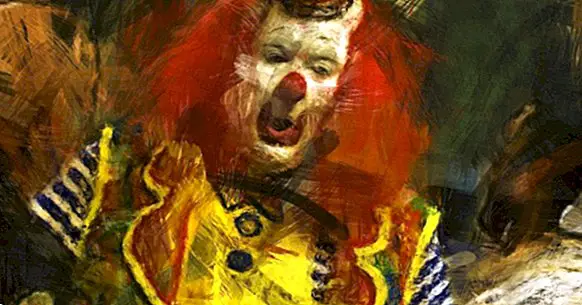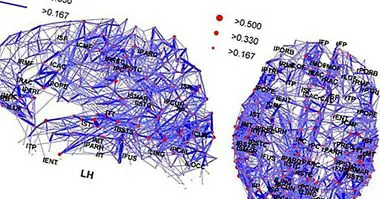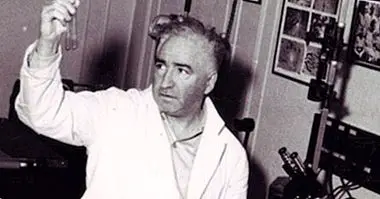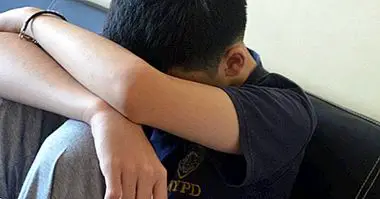Nightmares and night terrors: differences and similarities
Sleep disorders and sleep difficulties pose very frequent problems in childhood. It is called "parasomnias" those disorders characterized by abnormal events or behaviors associated with sleep, its specific phases or the periods of transition between sleep and wakefulness.
Within the parasomnias are included disorders such as sleepwalking, bruxism, nocturnal enuresis, nightmares and night terrors. Although these last two alterations are often confused, the truth is that the nightmares and night terrors have as many differences as similarities .
- Related article: "The 7 main sleep disorders"
What are nightmares?
A nightmare is a terrifying dream that creates strong feelings of fear or anguish. When the child awakens after a nightmare, it remains in contact with reality and responds appropriately to the environment. When you wake up, you usually remember the content of the dream.
The nigthmares happen during REM sleep phases , which occur to a greater extent during the second half of the night. REM sleep is characterized by high brain activity, lack of muscle tone, high respiratory frequency, rapid movements of the eyes and rapid and irregular pulse. It is precisely in this phase of the dream that most dreams usually occur, including nightmares.
It is one of the most frequent disorders in childhood and adolescence. According to studies, between 10 and 50% of children aged 3 to 6 suffer . Although nightmares do not usually pose a risk to the child's health, they can produce a certain fear of going to bed, especially if they are frequent. In these cases, the sleep pattern may be altered and secondary sleepiness, irritability, anxiety, etc. may appear secondarily.
- Maybe you're interested: "The 7 most frequent nightmares: what does each one mean?"
What are night terrors?
During episodes of night terror it is common for the child to sit abruptly on the bed and start scream, moan, babble or cry with a facial expression of terror . He keeps his eyes open without being really awake and shows signs of anxiety with great autonomic activation (tachycardia, hyperventilation, sweating, etc.). In addition, night terror occurs in the deep phase of sleep, when there is no muscle tone.
The appearance of this sleep disorder in adult ages is not ruled out, but it is in infancy that they are more frequent. Its start usually takes place between 4 and 12 years and it is estimated that between 1% and 6% of children suffer episodes of night terrors.
- Related article: "Night terrors: panic during sleep"
Why do they happen?
Factors such as emotional tension, traumatic events, anxiety, fatigue, irregular schedules of sleep, fever or taking some medications seem to increase the appearance of these sleep disorders.
Night terrors are usually attributed to the stress suffered by the child during the day; When going to sleep agitated increases the probability that an episode occurs. Unpleasant dreams are more frequent when the child is distressed or worried about something and often based on these concerns.
Unlike what happens in nightmares, hereditary factors seem to have a causal role in the presentation of night terrors. About 80% of the children who suffer from them have relatives who have also presented these sleep disturbances. Is genetic basis is shared with sleepwalking .
Differences between nightmares and night terrors
Fundamentally, the differences between nightmares and night terrors are as follows :
1. The possibilities of awakening
Unlike what happens in nightmares, in night terrors the child does not usually wake up easily despite the efforts of parents. If he wakes up, he is confused and disoriented, does not respond adequately to his environment and a certain sense of fear invades him. The episode usually lasts 10 to 20 minutes and then you can go back to sleep. Often the episode is not remembered when they wake up the next day, and if they remember something it is usually isolated and blurred fragments.
2. The sleep phase
Night terrors, like sleepwalking and unlike nightmares, arise in deep sleep and not during REM phases. They usually emerge during the first third of the night. During deep sleep the muscle tone is weak and the heart rate and respiratory rate decrease.
How to act before these episodes?
If our son suffers from nightmares or night terrors, it is best to act calmly, trying to normalize the situation.If children see their parents alarmed or worried their anxiety will be greater.
You also have to avoid intense light as this could lead to the child developing a phobia of darkness, associating it with fear. It is not a good idea to talk in detail with the child about what happened because he could become more active and this would make it difficult for him to fall asleep again.
It is advisable stay with the child until it has calmed down enough and you can fall asleep again, but you must stay in your room and sleep in your own bed. If parents transmit to their child that every time they have an episode they can sleep with them, they will reinforce the sleep disorder and encourage inappropriate habits.
Treatment of night terrors
The night terrors cause true panic in the parents, more than in the own child, that as we have seen normally will not remember the episode. In mild cases, parents should remain calm and Do not try to wake your child during the terror episode.
It is advisable to ensure that the child does not fall off the bed or suffer any physical damage during the episode, since he is deeply asleep and is not aware of what is happening around him.
Normally these sleep disorders disappear with time and they do not usually need psychological treatment , except in those cases that due to their frequency or intensity constitute a problem for the child and it is necessary to consult with a health professional.
Pharmacological treatment is not recommended with minors, since drugs such as benzodiazepines can produce important side effects and when they stop taking their benefits disappear, so in no case solve the problem.
An effective psychological technique in parasomnias such as night terrors and sleepwalking is the technique of programmed awakenings , which consists in awakening the child before the time when the disorder usually manifests itself. This is done to shorten the sleep cycle and thereby prevent the occurrence of the episode.
Nightmares treatment
Parents should try to reassure children after nightmares and try to put them back to sleep, trying not to be overly worried or anxious. For older children, from 7 or 8 years, you can talk about the nightmare the next morning, trying to find out if there is anything that worries you that may be responsible for these terrifying dreams.
If applicable, it is important promote proper sleep hygiene , that is, regular sleep patterns that help the child know that sleep is approaching.
It may also be convenient to avoid copious dinners and violent or frightening programs or movies that stimulate the imagination of the child, as well as to modify any inappropriate habit or stimulus that may disturb their rest.
In some serious and frequent cases of nightmares, when they have existed for a long time or they occur very often, they are very intense and cause a major discomfort, it may be advisable to go to a psychologist.
There are effective techniques that teach the child to successfully face the dreams that cause anxiety, such as Trial therapy in imagination, consisting of rewriting Y reimagine the dream so that its content stops generating fear.
Bibliographic references:
- Sierra, J.C., Sánchez, A.I., Miró, E. & Buela-Casal, G. (2004). The child with sleep problems. Pyramid Editions: Madrid.
- American Sleep Disorders Association (1997). The International Classification of Sleep Disorders, revised: Diagnostic and coding manual (2nd Ed.). Rochester: Minnesota.



















